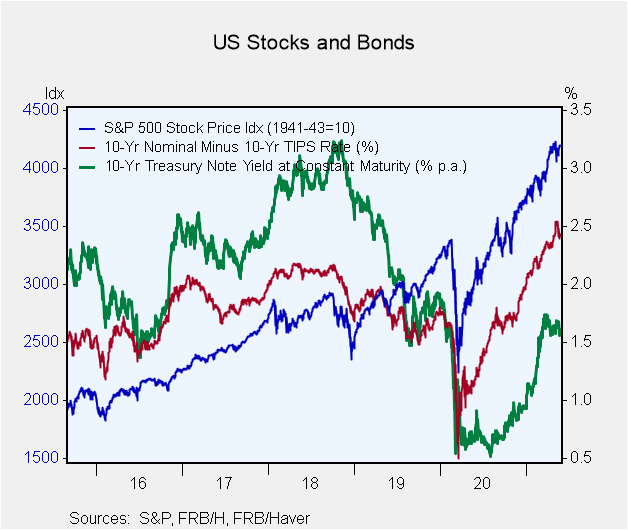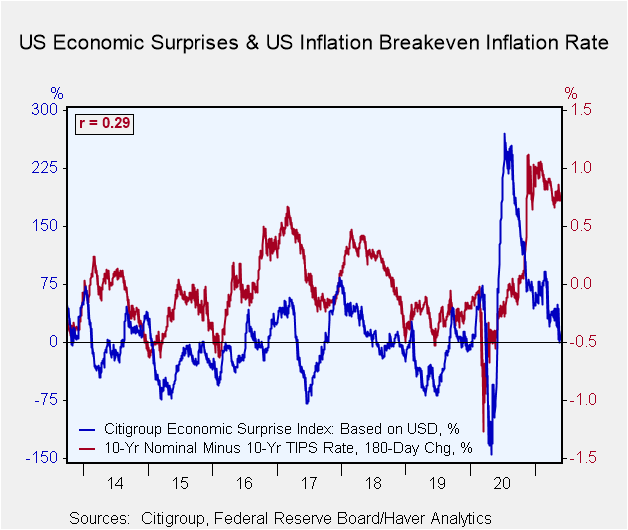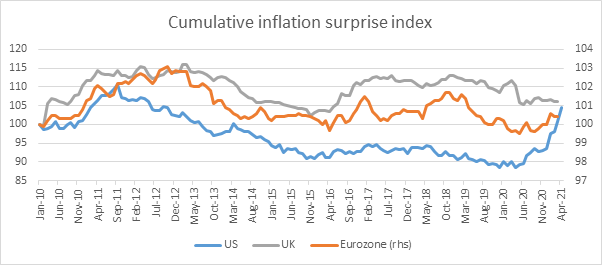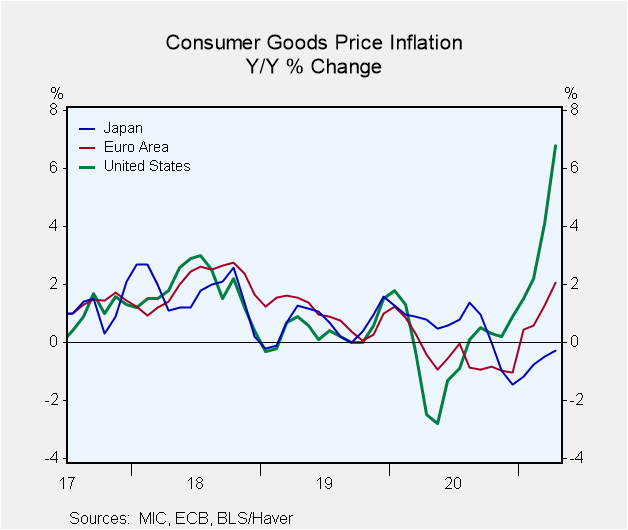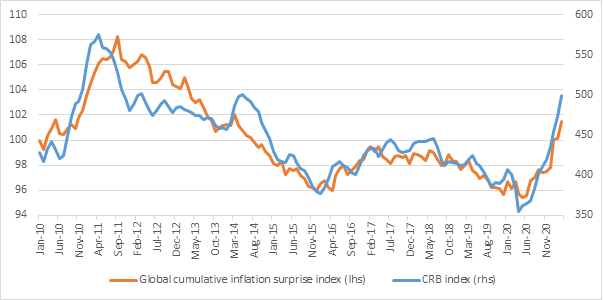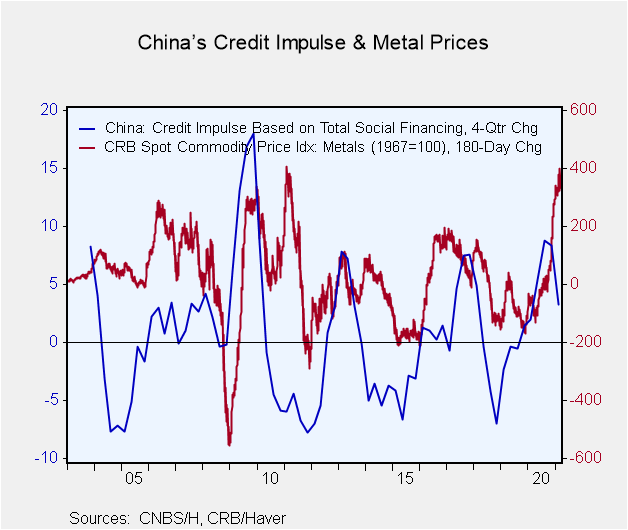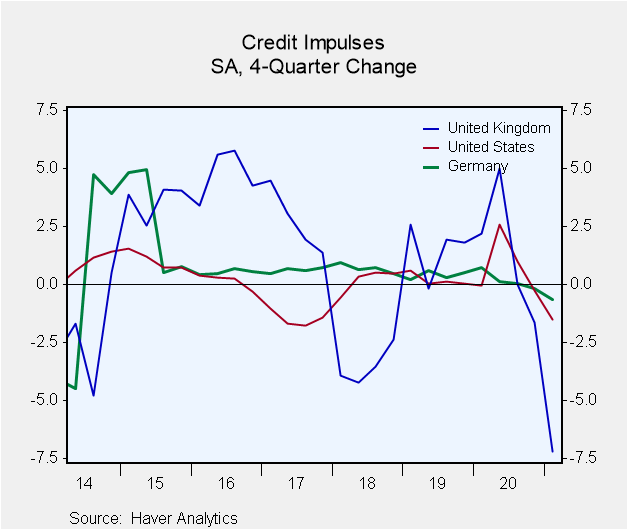 Global| May 27 2021
Global| May 27 2021The Inflation Debate Is Full of Surprises
by:Andrew Cates
|in:Viewpoints
Summary
Navigating the twists and turns of economic and financial market data has never been easy. But the interplay between economic outcomes and financial market outcomes is often the most perplexing. Who would have thought, for example, [...]
Navigating the twists and turns of economic and financial market data has never been easy. But the interplay between economic outcomes and financial market outcomes is often the most perplexing. Who would have thought, for example, that since the publication of April's US CPI figures on May 12th, a data set that exceeded US economists' expectations by a considerable margin, that financial markets would ostensibly shrug that data set off in the days that followed? For since May 12th, benchmark global equity indices have, on the whole, eked out further gains, US 10 Year Treasury yields have declined by around 8 to 9 basis points while US 10 year inflation breakeven rates have declined by around 9 to 10 basis points (see figure 1 below). That's not what textbooks would typically relay about financial market performance following a big inflation surprise.
Figure 1: Financial market performance: US stocks and bonds
Does this mean the US inflation shock was not that shocking? Putting this another way, are inflation doves, including most Central Bankers, right to argue that any recent and prospective climb in inflation is apt to be temporary? For if it is temporary then it won't have any major ramifications for the conduct of monetary policy, which is of course a key consideration for financial markets.
That's certainly one interpretation and it chimes with the views of this scribe. But it is still an unsettling interpretation in the absence of dataflow that can convincingly mute the inflation alarm bells.
There is sadly little, if any, dataflow at present that can mute those alarms. But there are, nevertheless, a few data points that offer a plausible explanation for why the volume of those alarm bells has been reduced, at least for now. They concern the interplay between growth and inflation surprises, commodity prices and the US dollar. Underlying credit conditions, particularly in China, are an additional consideration.
Consider first the interplay between growth surprises and financial markets. As discussed on these pages before (see, for example, The Power of Surprises) global growth surprises have tended to closely track financial market gyrations in recent years. Positive growth surprises tend to chime with rising equity market multiples, firmer inflation breakeven rates and (thus) higher bond yields. It should come as no surprise then that these inflation alarm bells have been ringing in financial markets in recent months at the same time as incoming economic data have consistently outpaced expectations. This is evidenced in figure 2 below.
Figure 2: Global growth surprises versus US inflation breakeven inflation rate
Yet as figure 3 below also suggests – and financial markets may have been responding to – incoming US economic data have not been behaving as positively in recent weeks. The Citigroup US economic surprise index, for example, has fallen back sharply and briefly dipped into negative territory about a week ago. That US bond yields – and US inflation breakevens in particular – have eased in recent weeks against that backdrop is – and forgive the pun – no surprise!
Figure 3: US growth surprises versus US inflation breakeven inflation rate
Insofar as the US dollar and commodity prices are important factors for the global inflation equation there are some additional considerations from this analysis that are equally of note. Firstly, as figures 2 and 3 suggest, data surprises from many developed and developing countries have tended to outperform US data surprises. And as figure 4 also suggests that's been of some importance for the US dollar. When US growth suprirses have underperformed surprises from the rest of the world, the US dollar has tended to depreciate in recent years and vice versa.
Figure 4: The trade weighted value of the US dollar versus relative growth surprises
This is noteworthy because much of the inflation tension that we've seen in the global dataflow in recent weeks has, by and large, been centred on the US. Incoming inflation data from Europe (and much of Asia including China and Japan) have been fairly well behaved compared with the US (see figure 5 below).
Figure 5: Cumulative inflation surprise index: US, Euro area and the UK
Source: Action Economics, Informa Global Markets, Haver Analytics Calculations. Based on Median Forecasts and Actual Outcomes for Consumer prices, Producer prices and Import and Export prices (US only). The aggregate monthly deviation in outcomes from forecasts is cumulated from January 2010.
That means though that the recent weakness of the US dollar could have been playing an important role in igniting US inflation tension. It's of note here that goods price inflation rates in the Euro area and Japan, while off their lows, seem relatively benign (at present) compared with the US (see figure 6 below).
Figure 6: Consumer goods price inflation in the US, Euro area and Japan
This though also plays into commodity price considerations not least given the links between those prices and the US dollar. As illustrated in a previous post on infation (see The Case Against An Inflation Surge) firmer global commodity prices certainly appear to be a key driver of global (and primarily US) inflation surprises in recent weeks (see figure 7).
Figure 7: Cumulative global inflation surprise index versus the CRB index
Source: Action Economics, Informa Global Markets, Haver Analytics Calculations. Based on Median Forecasts and Actual Outcomes for Consumer prices, Producer prices, and Import and Export prices (US only). The aggregate monthly deviation in outcomes from forecasts is cumulated from January 2010. The global aggregation is based on a weighted sum of the index for the US, Euro area and UK with respective weights of 0.5, 0.35 and 0.15.
Yet just as global growth surprises tend to chime with equity and bond market gyrations so too do they chime with commodity prices (see figure 8 below). And if US growth surprises have tended to falter in recent weeks clearly there is a good chance that economic activity in the rest of the world will not elicit such a strong capacity to surprise forecasters positively in the weeks ahead
Figure 8: Commodity prices versus global growth surprise index
Of course forecasting the evolution of global growth surprises is fraught with difficulty. Much will hinge on how the US and Europe evolve from here. But much will naturally hinge too on China, an economy incidentally often seemingly ignored in the global inflation debate in recent weeks. On that score though there may be a little more downside to global growth and inflation outcomes – in the near term - than the consensus seems to anticipate. Much of the recent dataflow from China has disappointed expectations in recent weeks and in particular the dataflow for consumer spending (e.g. retail sales). Perhaps of more significance though, underlying credit conditions appear to be deteriorating. Our measure of China's credit impulse, for example, based on aggregate social financing, has slowed quite sharply in recent months thanks to weaker private sector lending growth and a contraction in shadow bank lending. While the correlations are admittedly not that strong this slowdown – if sustained - may have negative ramifications for commodity prices in the period ahead (see figure 9 below). That view has added punch moreover when we throw in the credit impulses for several other major economies' which have also seen big slowdowns in recent months as well (see figure 10).
Figure 9: China's credit impulse versus metal prices
Figure 10: Credit impulses in the US, UK and Germany
Viewpoint commentaries are the opinions of the author and do not reflect the views of Haver Analytics.Andrew Cates
AuthorMore in Author Profile »Andy Cates joined Haver Analytics as a Senior Economist in 2020. Andy has more than 25 years of experience forecasting the global economic outlook and in assessing the implications for policy settings and financial markets. He has held various senior positions in London in a number of Investment Banks including as Head of Developed Markets Economics at Nomura and as Chief Eurozone Economist at RBS. These followed a spell of 21 years as Senior International Economist at UBS, 5 of which were spent in Singapore. Prior to his time in financial services Andy was a UK economist at HM Treasury in London holding positions in the domestic forecasting and macroeconomic modelling units. He has a BA in Economics from the University of York and an MSc in Economics and Econometrics from the University of Southampton.


